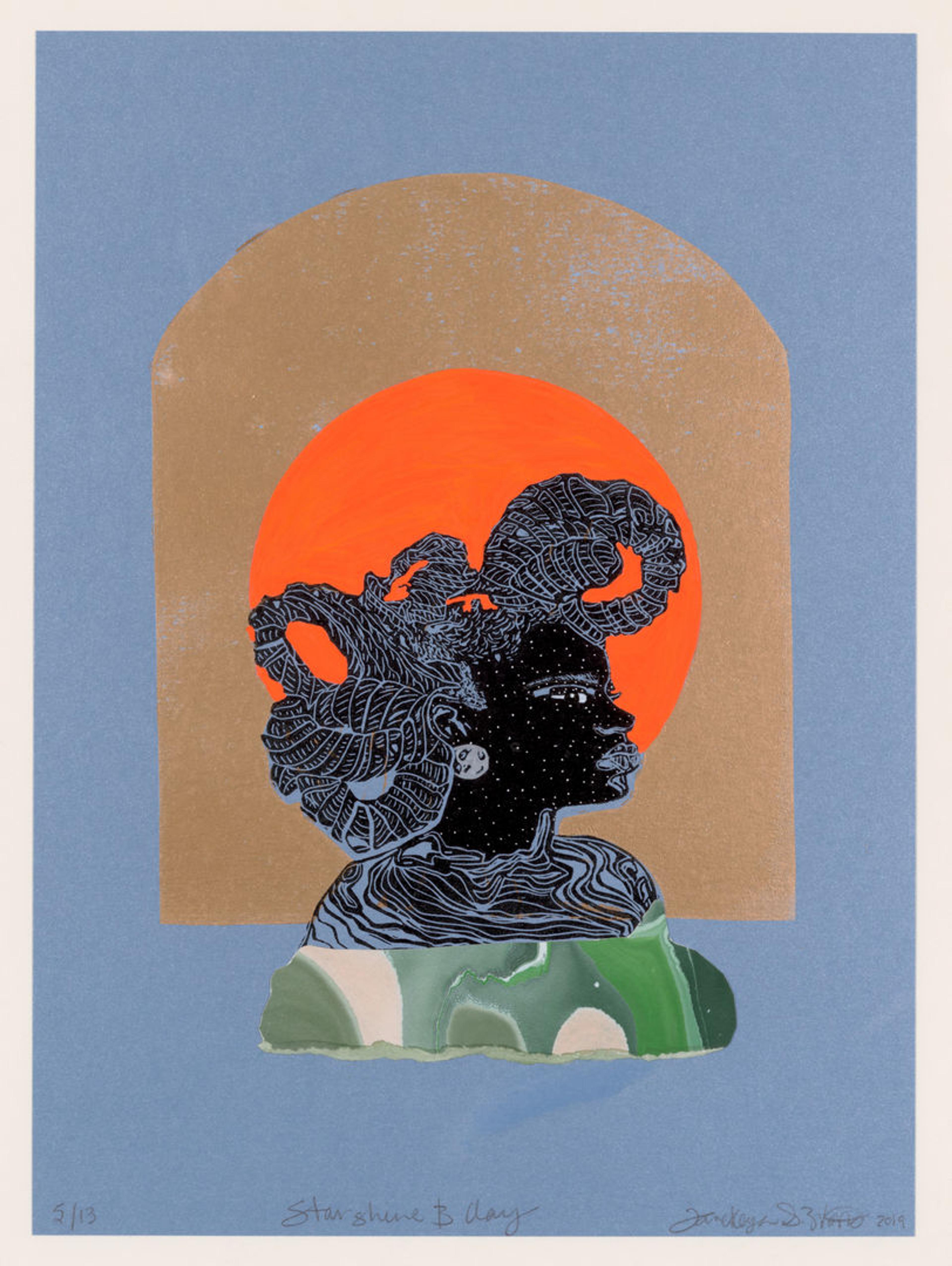Daughter of the ’80s, birthplace of the blues, bare feet running down Mississippi Delta dirt roads; hot summers spent dodging Johnsongrass to wade in the water baiting fishhooks for catfish and perch; traversing the unknown made familiar by a sixth sense; waving to friends returning from a long day in the cotton fields; picking: fruit from grandma’s trees, collards from her garden, grasping handfuls of freshly fallen pecans from her front yard; wishing upon stars in the wide open sky; cornrows and beads, babbles and barrettes, paint to brush, brayer to ink, pencil to paper blanketed in a rememory of Africa—“Mississippi is my Africa.”

Tanekeya Word (American, born 1983). Starshine & Clay, 2019. Linocut, gouache, acrylic ink, decorative paper collage, 11 × 15 in. (27.9 × 38.1 cm). The Metropolitan Museum of Art, New York. John B. Turner Fund, 2021 (2021.53.4) © Tanekeya Word
On the porch at the feet of my paternal grandmother, in the closet reviewing after-five attire with my maternal grandmother, at the kitchen table watching my mother draw blossoming Black girls and women as she herself blooms; primped, preened, adorned, and nurtured by aunties; spritz and sprays, sitting in salons amazed at the sculptural relics aloft the crowns of my cousin’s contestants; into the night, sisters imagining other worlds; we play, we laugh until we cry or we laugh to keep from crying, the blues, a soundtrack to daily life—I learned language from a Southern matriarchal lineage.
Early on, I understood language as a prepositional effect: there were varied versions of myself, conjured into the world and imagination, depending on self-perception and whose gaze marked me within proximity to my being, my body. In pursuit of belonging, I realized it was liminal: my identity is on the cusp of knowing the matrilineal African and Indigenous tribe of my people and in celebration of the folks and traditions I know for sure, when my feet hit the ground in Mississippi. Bound in a spatial sense that is triadic—a longing, a celebration, and an imagining of home—is a portal of possibilities: “here on this bridge / between starshine and clay.” [1]

Alison Saar (American, born 1956). High Cotton II, 2018. Linoleum cut, woodcut, and monotype on handmade chiri kozo paper, 25 × 16 3/4 in. (63.5 × 42.5 cm).
Starshine & Clay (2019), my mixed-media relief print included in Black Women of Print’s inaugural portfolio Continuum (2020), is a fantastical embodiment of the feelings I have about Black girlhood and Black womanhood. [2] Creating the print reminded me of an experience I had viewing Alison Saar’s High Cotton II(2018). Saar’s print glared back at me as if we were connected—the cotton plant, blues, and Black womanhood recognized me, and I them. This interaction, this kinship, further expanded my visual language of the power of representational art, of ways of seeing Blackness.
I am an artist, scholar, art educator, and cultural arts organizer interested in the ways Black girls and women inhabit space and conjure spirituality and imagination to make place. In other words, how Black women have the ability to see invertedly. Despite living alongside colonized geographies, we migrate beyond; on colonized soil, we remain central within our homeplace.
“I learned language from a Southern matriarchal lineage.”
Artistically kin to Alison Saar, I was drawn to the materiality of relief print within printmaking for this piece. Carving lends itself to disrupting the plane and excavating to uncover new terrain, to rendering the “ungeographical” as geographical. [3] Starshine & Clay is a visual autobiographical account on Black women’s intellectual thoughts that I carry with me and have expanded upon through artistic praxis.
My scholarship is a culmination of observations, lived experiences, and imaginings from childhood to adulthood. I coined the term everyday fantastical to define a way of seeing that centers Black girlhood and womanhood and their everydayness in harmony with the fantastical. It is a personal quest to unfold a continuous inquiry on who Black girls and women are—among and beyond us, and how we can imagine ourselves otherwise.
Notes
[1] Lucille Clifton, “won't you celebrate with me.” The Book of Light (Port Townsend, WA: Copper Canyon Press, 1993). Return
[2] “Womanist thought is spiritualized, it openly acknowledges a spiritual/transcendental realm with which human life, living kind, and the material world are all intertwined ... this realm is actual and palpable, and the relationship between it and humans is neither abstract nor insignificant to politics.” See Phillips Layli, The Womanist Reader (New York: Routledge, 2006). Return
[3] The scholar Katherine McKittrick defines Black geographies as “subaltern or alternative geographic patterns that work alongside and beyond traditional geographies.” See Demonic Grounds: Black Women and the Cartographies of Struggle (Minneapolis: University of Minnesota Press, 2006). Return
